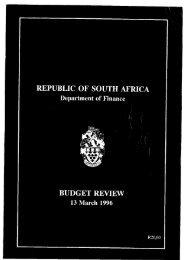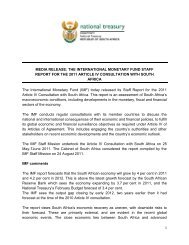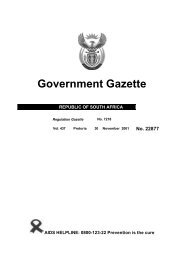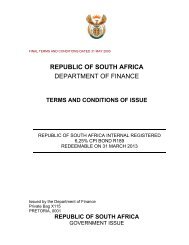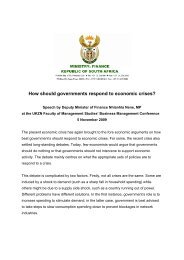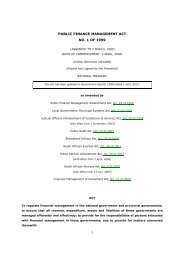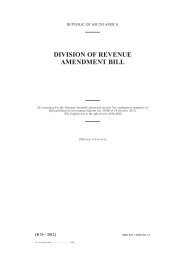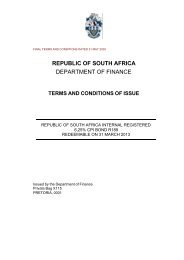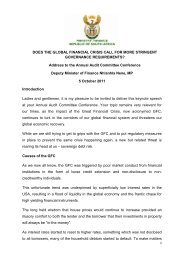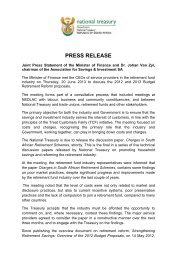1998 SOUTHERN AFRICA ECONOMIC ... - National Treasury
1998 SOUTHERN AFRICA ECONOMIC ... - National Treasury
1998 SOUTHERN AFRICA ECONOMIC ... - National Treasury
Create successful ePaper yourself
Turn your PDF publications into a flip-book with our unique Google optimized e-Paper software.
TA N Z A N I A<br />
exchange rate, the shilling ap p reciated from TZS 631.2 per USD<br />
in Ju ly 1997, to TZS 617.7 per USD by November 1997 befo re<br />
d e p reciating to TZS 631.3 per USD by December 1997. T h e<br />
d e p reciation has been on account of tight supplies of fo re i g n<br />
exchange in the marke t ,fo l l owing reduced export earnings.<br />
The external debt at 31st December 1997 was USD 7,931.2 m.<br />
Out of the total debt, disbursed outstanding debt was USD<br />
6,522.9 m, or 82.2 perc e n t , and committed undisbursed debt<br />
was USD 1,408.3 m, or 17.8 perc e n t .<br />
During the second quarter of 1997/98, the trade account<br />
re c o rded a deficit of USD 151.8 m.The poor performance was<br />
l a r g e ly attributed to a big drop in export earnings. E x p o rt<br />
receipts decreased by 19.9 percent to USD 202.6 m, w h e re a s<br />
the import bill increased slightly to USD 354.4 m.<br />
Financial In s t i t u t i o n s<br />
Ta n z a n i a ’s central bank, the Bank of Ta n z a n i a ,was established in<br />
1 9 6 6 .The primary objective of the bank, as outlined in the Bank<br />
of Tanzania Act of 1995, is “..to fo r mulate and implement<br />
m o n e t a ry policy directed to the economic objective of<br />
maintaining price stability, c o n d u c i ve to a balanced and<br />
sustainable growth of the national economy of Ta n z a n i a .”<br />
In 1991, the financial services sector was opened to private and<br />
fo reign cap i t a l . A l ready sixteen fo reign banks and nine non-bank<br />
financial institutions have been licensed to do business in<br />
Ta n z a n i a . M o re than 80 bureaux de change are curre n t ly in<br />
o p e r a t i o n .<br />
B e fo re the deregulation of the financial sector,Ta n z a n i a ’s stateowned<br />
<strong>National</strong> Bank of Commerce dominated the banking<br />
s e c t o r, cornering 70 percent of the marke t . The <strong>National</strong> Bank<br />
of Commerce is due for privatisation soon;the bank will be split<br />
into three separate entities - a regional bank, a trade bank and a<br />
m i c ro finance bank. C u rre n t ly, the focus is mainly on the<br />
corporate sector rather than in the retail marke t .F u rt h e r m o re,<br />
t h e re is a need for more finance for micro enterprises.<br />
Liberalisation of the financial services sector and the<br />
establishment of open markets in fo reign exchange and<br />
government paper have extended the scope for the<br />
implementation of an active monetary policy. I n t e rest rates have<br />
been liberalised and are now determined fre e ly by the marke t .<br />
Since the launching of regular Tre a s u ry Bill auctions in A u g u s t<br />
1 9 9 3 ,it has been possible for the central bank to set its discount<br />
rate on the weighted average yield of all maturities.<br />
Dar es Salaam Stock Exchange<br />
The Dar es Salaam Stock Exchange is fo r m a l ly scheduled to<br />
begin operations on 15 April <strong>1998</strong>. The Capital Markets and<br />
Securities Authority was tasked with developing the rules and<br />
re g u l a t i o n s ,and with launching the stock exchange marke t .<br />
When it opens for business, the stock exchange will have one<br />
quoted company, n a m e ly Tanzania Oxygen. It is expected that<br />
Tanzania Breweries and Agip will list on the exchange in <strong>1998</strong>.<br />
The exchange operates on a three-tier system, the first tier<br />
being listed shares that meet international listings re q u i re m e n t s ,<br />
the second tier having less stringent re q u i rements and the third<br />
being an ove r-the-counter tier, for those which fail to meet the<br />
conditions for the first two segments. F i ve stockbro kers we re<br />
licensed in June 1997.<br />
Fo reign Tr a d e<br />
Main export goods are agricultural commodities such as coffe e,<br />
t e a ,t o b a c c o, c o t t o n ,and cashew nu t s . E x p o rts of manu f a c t u re s<br />
h ave been growing steadily during the 1990s, and accounted fo r<br />
16 percent of total exports in 1995. I m p o rted products are<br />
m a c h i n e ry, textiles and ap p a re l ,fuel and transport equipment.<br />
Ta n z a n i a ’s main export markets are Germany, the UK, t h e<br />
N e t h e r l a n d s ,China and the USA. I m p o rts are sourced from the<br />
U K ,G e r m a ny, J ap a n ,I t a ly and France.<br />
Tanzania now has a compre h e n s i ve liberalised trade re g i m e.<br />
Restrictions on imports have been re m oved (except for those<br />
items on which control is necessary for health or security<br />
re a s o n s ) ,e x p o rt and import pro c e d u res have been simplified<br />
and single channel export of traditional crops has ended. Fo r<br />
statistical purposes, all imports still need to be declared on an<br />
i m p o rt fo r m .<br />
Tanzania is a member of SADC and COMESA.<br />
Fo reign Di rect Inve s t m e n t<br />
Fo reign direct investment into Tanzania has incre a s e d<br />
s u b s t a n t i a l ly over the past two ye a r s .Most of the fo reign dire c t<br />
i nvestment into Tanzania flows into the mining and exploration<br />
sector - during 1997,Tanzania re c e i ved investments to the value<br />
of USD300m in mining and exploration.The companies invo l ve d<br />
h ave included Sutton Resources (Buly a n h u l u ) ,Pangea Goldfields<br />
of Canada and Randgold of South Africa (Golden Ridge in<br />
S u k u m a l a n d ) ,and Resolute of Australia and Samax Resources of<br />
Britain (Golden Pride on Lake V i c t o r i a ) .<br />
Other major investments in 1997 included a USD50m<br />
i nvestment by South African Breweries in a new brewe ry, a<br />
USD55m investment by R.J. R eynolds in the Tanzania Cigare t t e<br />
C o m p a ny. Substantial opportunities for investment have also<br />
been created by Ta n z a n i a ’s privatisation programme (see below ) .<br />
P r i v a t i s a t i o n<br />
The Parastatal Sector Reform Commission manages the<br />
d i ve s t i t u re of non-performing government parastatals. By the<br />
end of 1997, ap p rox i m a t e ly 150 companies had been privatised.<br />
The first sugar firm to be privatised in Tanzania is Kilombero<br />
S u g a r.The company was bought by Illovo Sugar Limited of South<br />
Africa and F Man Ground from the UK in March <strong>1998</strong>. Due fo r<br />
privatisation soon is the <strong>National</strong> Bank of Commerc e.<br />
Fo reign investors participating in Ta n z a n i a ’s privatisation programme so far have included the fo l l ow i n g :<br />
International Company<br />
I nve s t m e n t<br />
R . J .R eynolds (Switzerland)<br />
Tanzania Cigarette Company<br />
Tadema (Switzerland) 77 percent stake in New Africa Hotel in 1993<br />
W i l c roft (South Africa)<br />
75 percent of Williamson Diamonds Ltd<br />
Asea Brown Boveri (Switzerland) 70 percent of TA N E L E C<br />
Holderbank (Switzerland)<br />
60 percent of Tanga Cement<br />
S CANCEM (Scandinavia)<br />
60 percent of Tanzania Po rtland Cement<br />
Carnaud Metal Box (UK)<br />
CMB Ta n z a n i a<br />
Dae Sung (South Ko rea)<br />
Tanzania Cables<br />
Kabool (South Ko rea)<br />
M o ro go ro Po lye s t e r<br />
Modern Trading Agencies (Saudi Arabia) <strong>National</strong> Engineering Company<br />
A commitment has been made by the government to privatise Tanzaniaís major public utilities, including water, s ewe r a g e,<br />
t e l e c o m munications and electricity.<br />
93



